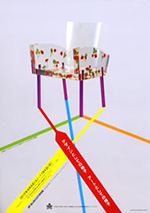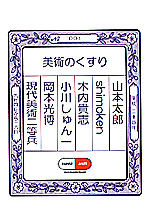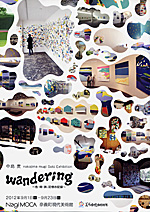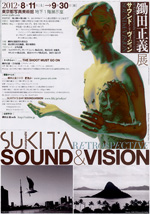 |
Picks is a monthly sampling of Japan's art scene, offering commentary by a variety of reviewers about exhibitions at museums and galleries in recent weeks, with an emphasis on contemporary art by young artists. |
 |
 |
 |
1 November 2012 |
 |
| 1 | 2 | |
 |
|
 |
 |
|
|
 |
 |
 |
 |
| The 70s in Japan, 1968-1982 |
| 15 September - 11 November 2012 |
The Museum of Modern Art, Saitama
(Saitama) |
 |
| For Japan the seventies was a decade of transition, as the high-growth era peaked out and made way for a consumerist, information-driven society. Culturally it was a tumultuous time. This ambitious and possibly first-of-its-kind retrospective aims to "look back at the art, design, architecture, photography, theater, music, and manga that reflect the era" of about 15 years that loosely defines the seventies. The museum has stuffed its galleries with works that all bear looking at. Hats off to the curators who pulled all this material together. |
|
 |
|

|
 |
 |
 |
|
Tatsuno Art Project 2012: Arts and Memories |
| 16 - 25 November 2012 |
Usukuchi Tatsuno Soy Sauce Museum, etc.
(Hyogo) |
 |
| In its second year, this contemporary art festival occupies former soy-sauce warehouses and other traditional structures in the old castle town of Tatsuno, outside Himeji. The featured artists, all of high repute and many of whom make their home overseas, span the generations from the venerable painter Takesada Matsutani (b. 1937), a former member of the legendary Gutai art collective who now lives in France, to Madrid-based sculptor Toshiro Yamaguchi (b. 1956), to young lion Ryosuke Imamura (b. 1982), an installation artist from closer by in Kyoto. The weeklong event includes plenty of workshops, artist talks, and guided tours. |
|
|
 |
 |
|
Chair as Design / Chair as Art |
|
8 September - 4 November 2012
|
|
The Museum of Modern Art, Toyama
(Toyama) |
 |
| Selecting from its own collection, the museum exhibits over 100 chairs in a solid retrospective of chair design in the 20th century, ranging from the art nouveau era of Otto Wagner and Antonio Gaudi to the postmodernism of Ettore Sottsass and Arata Isozaki. Especially gratifying is the display of concurrently produced artworks alongside the furniture. This makes for some surprising juxtapositions, such as a painting by Tadanori Yokoo paired with a chair by Shiro Kawamata. |
|
|
|
|
|
|
|

|
 |
 |
|
|
|
|
|
 |
 |
 |
|
|
Bijutsu no Kusuri (Medicine of Art)
|
|
4 - 16 September 2012
|
Kunst Arzt
(Kyoto)
|
 |
| Artist Mitsuhiro Okamoto has opened his new Kyoto gallery (the name means "Art Doctor" in English) with the aim, he says, of "providing stimulating 'medicine' to visitors and society in general." This inaugural show introduced works on the medicinal theme by six artists or art units: Taro Yamamoto, shimoken, Gendaibijutsu Nitouhey, Takashi Kiuchi, Shunichi Ogawa, and Okamoto himself. Laced with an invigorating wit, the works filling the gallery consistently elicited appreciative grins and guffaws. |
|
|
|
|
|
|
 |
 |
|
| Mugi Nakajima: wandering |
| 1 - 23 September 2012 |
Nagi Museum Of Contemporary Art
(Okayama) |
 |
| Subtitled "color, time, travel, a record of memory," this was a fulfilling show that provided an overview of Nakajima's evolution as an artist, the changes his mode of expression has undergone, the breadth of his viewpoint, and the way-stations on his artistic journey. In an artist's talk he spoke of his everyday experiences, his stance as an artist, and what he likes to collect -- all delivered with a calm, reflective demeanor that was contagious to the audience. |
|
 |
 |
 |
|
| Masayoshi Sukita: Sound & Vision |
| 11 August - 30 September 2012 |
Tokyo Metropolitan Museum of Photography
(Tokyo) |
 |
| As befits a retrospective of the celebrated photographer (best known overseas for his shots of David Bowie, Marc Bolan, and the like), this show focused on his work since the 1970s across the spectrum of Japanese culture -- particularly in music and film, represented by record jackets, posters, and movie stills, but interspersed with examples of more personal work as well. Classified under such titles as "Early Days / Mother, Kyushu, Osaka," "70's / New York and Rock 'n Roll," "Vision 1: Afterimage Spectral," and "Vision 2: Tokyo Images+," the works occupied several small sub-galleries, an effective way of showcasing both the origins and methodology of Sukita's oeuvre. |
|
|
|
|
 |
|
|
 |
|